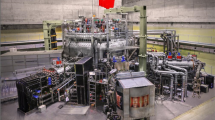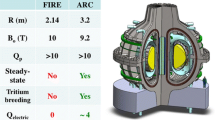Abstract
Recent experimental results and advances in magnet engineering suggest that super high-field, high-aspect ratio tokamak devices could be a very efficient way to achieve burning plasma conditions and could open up a new area of research. Copper magnet devices with fields of 13 to 25 T at the plasma are considered. The super high-field approach could also provide advantages for ETR and demonstration/commercial reactor concepts (magnetic fields at the plasma in the 8–13 T range).
Similar content being viewed by others
References
D. R. Cohn and L. Bromberg, to be published in theJ. Fusion Energy.
D. R. Cohn, L. Bromberg, R. Potok, and D. L. Jassby, to be published inNuc. Technol./Fusion.
D. R. Cohn, R. R. Parker, and D. L. Jassby,Nucl. Fusion,16 (1976), 31; D. L. Jassby, D. R. Cohn, and R. R. Parker,Nucl. Fusion,16 (1976), 1045.
G. E. Guest, R. L. Miller, W. W. Pfeiffer, and R. E. Waltz, Proceedings of the Finite Beta Theory Workshop, U.S. DOE Conference-7709167, (1977) 115; W. Pfeiffer and R. E. Waltz,Nucl. Fusion,19 (1979), 51.
S. Fairfax et. al.,Plasma Physics and Controlled Nuclear Fusion Research, Vol. 1 (IAEA, Vienna, Austria, 1980), p. 439.
D. R. Cohn, L. Bromberg, and D. L. Jassby,Proceedings of 11th Symposium on Fusion Engineering, Austin, Texas (1985).
R. J. Taylor, Ignition criterion for tokamaks from loop voltage data, UCLA Center for Plasma Physics and Fusion Engineering, PPG-831 (1985).
B. Coppi,Comm. Plasma Phys. Controll. Fusion,3 (1977), 47.
B. Coppi,Proceedings of the 11th Symposium on Fusion Engineering, Austin, Texas (1985).
R. A. Jacobsen, C. E. Wagner, and R. E. Covert,J. Fus. Energy,3 (1983), 217.
W. Weldon, M. D. Driga, and H. H. Woodson, Texas Atomic Energy Research Foundation Project, Project Report No. 40, April 1985, p. 35.
S. M. Wolfe, D. R. Cohn, R. J. Temkin, and K. Kreischer,Nucl. Fusion,19 (1979), 387.
D. R. Cohn, J. E. C. Williams, L. Bromberg, K. Kreischer, D. B. Montgomery, and R. R. Parker, Fusion reactor design concepts, Second IAEA Meeting on Fusion Reactor Design, Madison, Wisconsin, Oct. 1977, IAEA-TC-145/8 (1978).
L. Bromberg et. al.,Proceedings of the 11th Symposium on Fusion Engineering, Austin, Texas, 1975.
CIT Conceptual Design Report, June 1986.
L. Bromberg, private communication.
J. Schwartz and J. Williams, private communications.
Author information
Authors and Affiliations
Rights and permissions
About this article
Cite this article
Cohn, D.R. Future directions in fusion research: Super high-field tokamaks. J Fusion Energ 6, 281–284 (1987). https://doi.org/10.1007/BF01050794
Received:
Issue Date:
DOI: https://doi.org/10.1007/BF01050794




